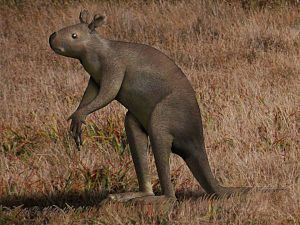- Sthenurus
-
Sthenurus 
Sthenurus stirlingi (Rekonstruktion)
Zeitraum Pliozän bis spätes Pleistozän ca. 4 Mio. Jahre bis ca. 50.000 Jahre Fundorte Systematik Beutelsäuger (Metatheria) Diprotodontia Macropodidae Sthenurinae Sthenurus Wissenschaftlicher Name Sthenurus Owen, 1873 Sthenurus war eine Gattung großer, ausgestorbener Kängurus. Die Tiere lebten in Australien bis ins späte Pleistozän.
Inhaltsverzeichnis
Merkmale
Der wissenschaftliche Name Sthenurus bedeutet so viel wie Tier mit kräftigem Schwanz. Die Benennung ist insofern eigenartig, als dass damals (1873) nur Zähne, Unterkiefer und Schädelfragmente bekannt waren. Kurioser Weise hatten die Tiere allerdings tatsächlich robuste Schwänze, was sich zeigte als etwa hundert Jahre später vollständigere Skelette geborgen wurden.
Sthenurus gehörte wie Simosthenurus und Procoptodon in die Gattung der Sthenurinae. Im Vergleich zu diesen beiden Gattungen, die ebenfalls bis zum Ende des Pleistozän überlebten, hatte Sthenurus allerdings eine relativ lange Schnauze.[1]
Arten und zeitliche Verbreitung
Die Gattung Sthenurus scheint eine primitive Schwestergruppe der Simosthenurus-Procoptodon-Linie darzustellen und erscheint vor 4 Millionen Jahren erstmals im Fossilbericht. Alle Arten der Gattung verschwanden im späten Pleistozän, offenbar vor mindestens 30.000 Jahren. Eine Art des Spätpleistozän war etwa Sthenurus atlas.[1]
Quellen
Einzelnachweise
- ↑ a b J. Long, M. Archer, T. Flannery und S. J. Hand: Prehistoric Mammals of Australia and New Guinea: One Hundred Million Years of Evolution. University of New South Wales, Kensington 2002, S. 161-162
Literatur
- John Long, Michael Archer, Timothy Flannery, Suzanne Hand: Prehistoric Mammals of Australia and New Guinea. One Hundred Million Years of Evolution. University of New South Wales, Sydney 2002, ISBN 0-86840-435-7, S. 161–162.
Weblinks
 Commons: Sthenurus – Sammlung von Bildern, Videos und AudiodateienKategorien:
Commons: Sthenurus – Sammlung von Bildern, Videos und AudiodateienKategorien:- Kängurus
- Ausgestorbenes Säugetier
- Macropodidae
Wikimedia Foundation.

